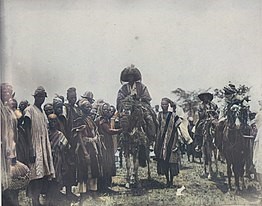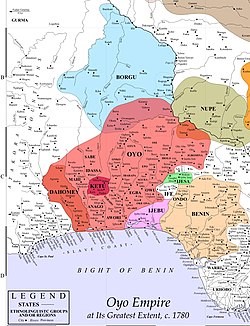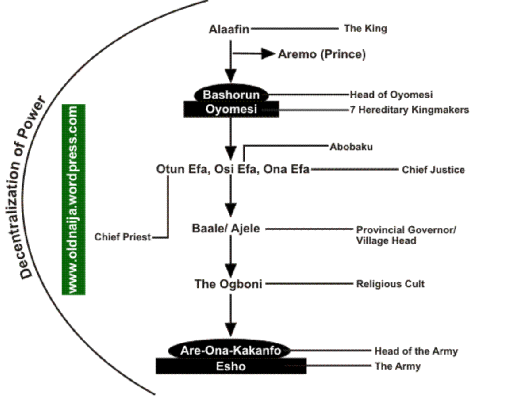First Alaafin or of the powerful Yorùbá kingdom of Oyo was Ọranyan. He founded Oyo made him the first Alaafin at around the year 1300. The Old Oyo Empire was one of the strongest if not the strongest in the Yoruba mythology.

Alaafin of Oyo c.1910
Oyo-Ile (not the modern-day Oyo) has a lot of stories surrounding it, being the chosen place for many of the Yoruba gods and warriors, likewise kings and people of great reputation.
The Oyo empire was a monarchical one and ruled by an Alaafin (king), (Alaafin means ‘owner of the palace’ in the Yoruba language). However, an administrative council and governing body, made up of chiefs (Oyo Mesi) served to maintain a balance in power. The Oyo Mesi were the seven principal councilors of the state. They constituted the Electoral Council and possessed legislative powers, similar to today’s National Assembly, Parliament and Congress.

Oyo Empire at Its Greatest Extent, c.1780
Oyo Mesi was led by the Bashorun, acting as prime minister, who was assisted by the Agba-Akin, Samu, Alapini, Laguna, Akiniku and Ashipa. They embodied the nation’s voice and had the chief duty to protect the empire’s interests.
The Alaafin was expected to take the counsel with them if there was any important matter that affected the state. Every man had a state responsibility to perform in court every morning and afternoon. Each member also had a deputy whom they would send to the Alaafin if his absence was unavoidable.
The Oyo Mesi acted as a check and balance on the Alaafin’s power, preventing the king from being an autocrat; the council forced many Alaafin to commit suicide during the 17th and 18th centuries. The head of the Oyo Mesi known as the Bashorun who would consult the Ifa oracle for approval from the gods. The new Alaafin of Oyo was seen as appointed by the gods. They were regarded as Ekeji Orisa (companion of the gods.)
In 1754, Gaa was named the Basorun of Oyo. He was a descendant of the famous Basorun Yau Yamba. was a brave and powerful man who was respected and feared by the people of Oyo-Ile for his potent charms and supernatural strength. Bashorun Gaa being the head of the Oyo Mesi (the Oyo council of Kingmakers) became too powerful during that period supervising and executing the death of four Alaafins in quick succession. Bashorun Gaa was an integral part of the Old Oyo Empire’s royal politics. No story of Oyo-Ile would be complete without a mention of his name.

Bashorun Gaa was instrumental to the military conquests during his time as a Prime Minister of the Old Oyo Empire during the 17th/18th century.
During the 17th century Oyo Kingdom, the monarchical failings came with a succession of uncharitable kings to the exalted throne. From Odarawu (who was bad tempered) to Kanran (an unmitigated tyrant) then Jayin (the effeminate and dissolute) down to Ayibi (the cruel and arbitrary) and Osinyago (the worthless) the Alaafin’s in the second half of the 17th century were despotic.
He was Bashorun from 1750–1774 and was believed to have grown up during the reign of the 9 Alaafins. They were terrible kings and this could have affected his view of the office.
The unwritten Constitution which gave Bashorun (prime minster) a final say on the nomination of the new Alaafin and the control of the kingmakers was so great that the Bashorun ’s power rivaled that of the Alaafin himself. This of course was an open opportunity for Bashorun Gaa to have absolute control of the political machinery of old Oyo kingdom of his time in his palms.
Power drunk, Bashorun Gaa became a classical tyrant during the Yoruba pre-colonial era breaking the support he had among the people against tyrant kings. The one who fights the tyrants became a feared tyrant himself.
Bashorun Gaa, unconstitutionally hijacked all the political power and machinery of Oyo kingdom. All the homage, respects and the material benefits meant for the kings were diverted to his personality. This was a great crime against the royal political system and great assault to the gods of the land and the past ancestors.’

Pre-colonial Political Administration of the Oyo empire
He was also said to have been a crime instigator. He was fond of aiding, abetting and covering the crimes committed by the people of his household. The history recorded the serial killings committed by his sons and head slave. The criminals were protected by him and even punished those who reported the crime.
The Bashorun ordered the massacre of the family members of one of his wives who was alleged to have attempted to poison him. He was however already poisoned by the last Alaafin he killed, Alaafin Majeogbe. The poison left him weak, paralyzed and vulnerable.
Bashorun Gaa’s end was believed to have come during the reign of Alaafin Abiodun who ruled from 1774–1789.
References:
Endre Stiansen; Jane I. Guyer (1999). Credit, Currencies, and Culture: African Financial Institutions in Historical Perspective. Nordic Africa Institute. ISBN 9789171064424.
^ Jump up to:a b c Usman, Aribidesi (2019). The Yoruba from prehistory to the present. Toyin Falola. Cambridge, United Kingdom. p. 151. ISBN 978-1-107-06460-7. OCLC 1082296168.
- Ola Abiola; A Textbook Of West African History; 3rd edition; Ado Ekiti; Omolayo Standard Press & Bookshops co. (Nig.) Ltd; 1984
Cite this article as: Teslim Omipidan. (August 26, 2018). The Reign of Bashorun Gaa in Old Oyo Empire. OldNaija. Retrieved from https://oldnaija.com/2018/08/26/the-reign-of-bashorun-gaa-in-old-oyo-empire/



This was so helpful,thank you